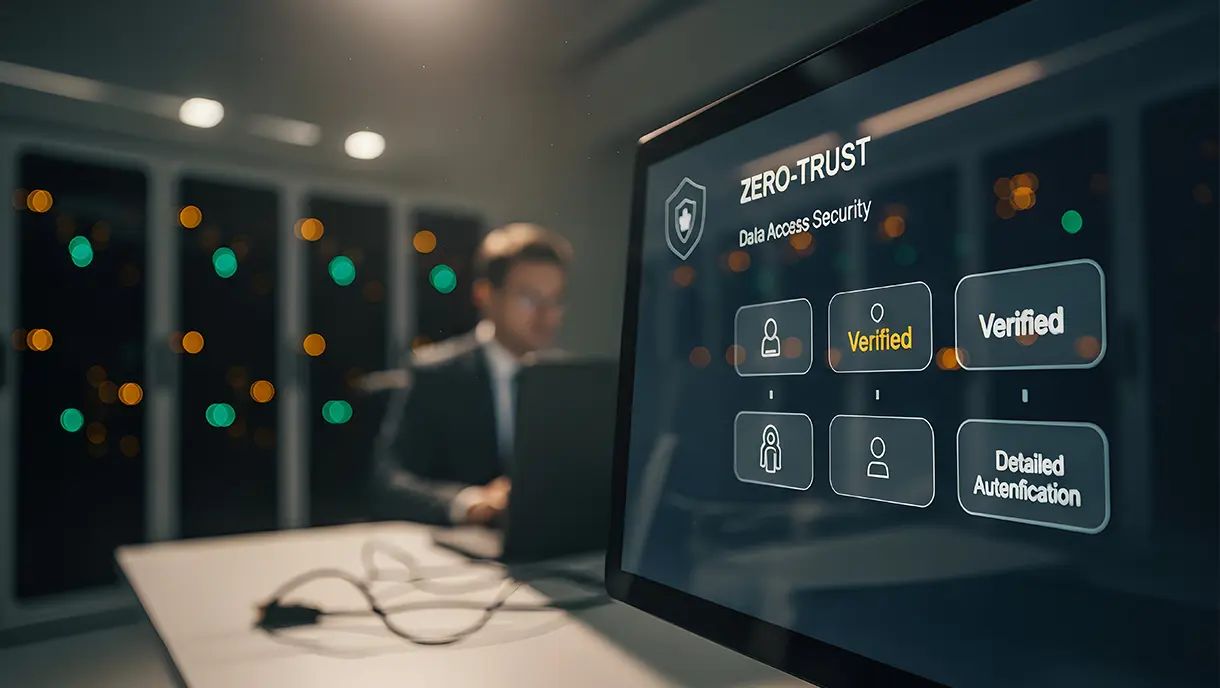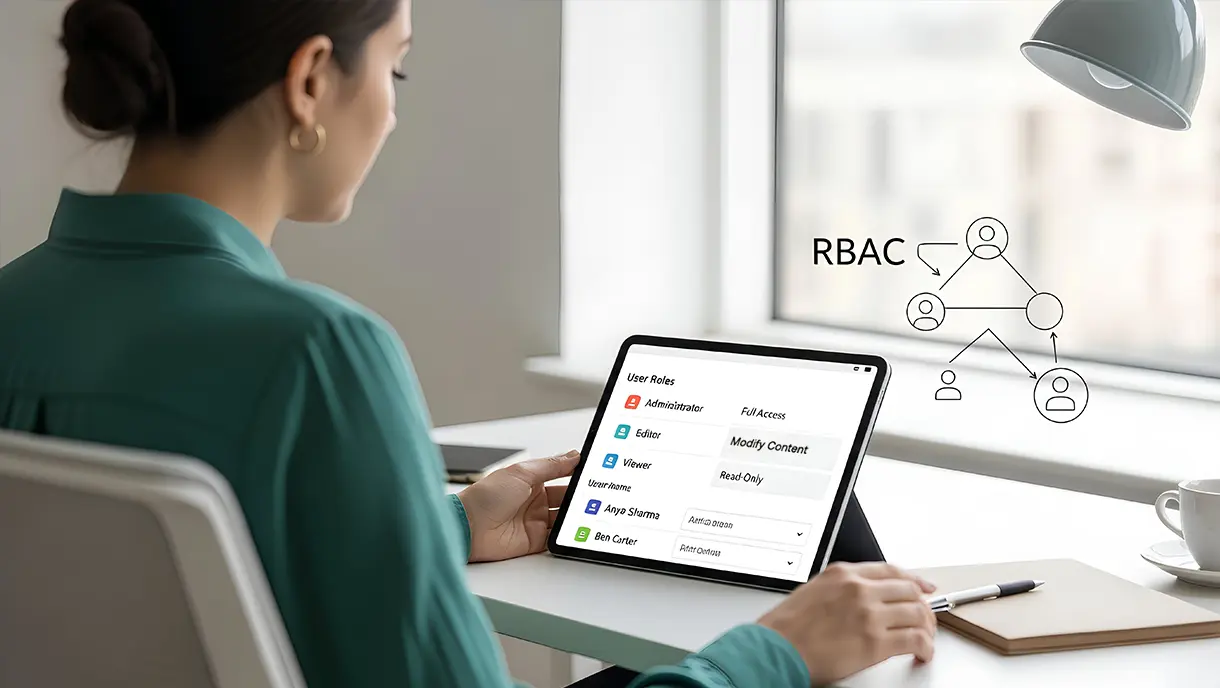Complete Zero Trust Security Guide for Modern Businesses
Zero-Trust Security represents a fundamental shift in how organizations approach cybersecurity in today's digital landscape. This framework operates on the principle that no user or device should be trusted by default. The guide covers core zero-trust principles, compelling benefits, and practical implementation strategies for modern enterprises. Explore the real-world applications of Zero-Trust across remote work, cloud security, and compliance scenarios.

IT and security teams are operating in a world where the stakes have never been higher. According to IBM, the average cost of a data breach reached 4.88 million dollars in 2024. At the same time, organizations are managing a workforce that connects from everywhere, applications that run across multiple clouds, and data that flows through countless devices.
With so much moving beyond the traditional network perimeter, how do organizations protect their environments without relying on old security assumptions? This is what leads them to zero-trust architecture.
Zero-Trust security eliminates implicit trust and continuously verifies every access request. This framework assumes breach scenarios and treats every user, device, and network as potentially compromised. Organizations implementing zero-trust security experience lower breach impact than those using traditional security models.
This guide breaks down what zero trust really means, why it matters now more than ever, how the model works in practice, and the challenges organizations should expect along the way. Learn real use cases and how zero trust can help protect data, secure hybrid work, and strengthen compliance.
What Is Zero-Trust Security?
Zero-Trust security is a cybersecurity framework that assumes no user or device should be trusted by default. Every access request must be verified, regardless of where it originates. The goal is to ensure that only authenticated users and compliant devices can access the specific resources they need.
The core principle behind this model is “never trust, always verify.” Verification happens continuously. Users must confirm their identity, devices must meet security standards, and access is granted only for the required task or session. Trust is not permanent. It is reassessed each time a request is made.
This approach is very different from traditional perimeter-based security. In older models, once a user enters the network, they often have broad access to systems and data. This creates a significant risk if an attacker or insider gains entry. The Zero-Trust architecture removes this implicit trust. It limits access, validates each interaction, and monitors activity across all environments.
Key Principles of Zero-Trust Security
Zero trust security is built on a set of foundational principles that guide how organizations verify users, control access, and protect sensitive data. These principles provide a structured approach to reducing risk across modern IT environments where users, applications, and devices operate inside and outside the traditional network.
1. Least Privilege Access
Least privilege grants users only the minimum permissions necessary to perform specific job duties. This principle prevents the over-provisioning of access rights, which can create security vulnerabilities and compliance risks.
Users receive temporary, limited access to resources rather than permanent, broad permissions across systems. Organizations regularly review and adjust permissions as roles change to maintain appropriate access levels.
2. Microsegmentation
Microsegmentation divides networks into isolated zones that contain specific workloads, applications, or data classifications. This granular segmentation prevents attackers from moving laterally across networks after initial system compromise.
Each segment enforces unique security policies based on sensitivity, compliance requirements, and threat profiles. Breaches remain contained within small segments rather than spreading throughout entire enterprise networks.
3. Continuous Monitoring and Verification
Continuous monitoring analyzes user behavior, device health, and access patterns throughout active sessions. The system doesn't trust initial authentication alone; instead, it verifies legitimacy constantly during resource access.
Anomaly detection identifies suspicious activities, such as unusual login locations, abnormal data transfers, or privilege escalations. Real-time alerts enable security teams to respond promptly to potential threats before significant damage occurs.
4. Strong Identity and Access Management
Strong identity and access management verifies user identity through multi-factor authentication, combining passwords, biometrics, and tokens to enhance security. Access decisions consider user attributes, device security posture, location, time, and the sensitivity of the requested resource.
Identity governance ensures consistent policy enforcement across cloud applications, on-premises systems, and hybrid environments. Centralized access management simplifies administration while strengthening security controls across diverse technology platforms.
When these principles work together, they create a security foundation that strengthens every layer of your environment and delivers the measurable benefits that zero trust is known for. The coming section highlights these benefits.
Why Zero-Trust Security Matters: 6 Compelling Benefits
Zero-Trust security is a practical response to the rising volume of cyberattacks, the shift to cloud environments, and the growing number of devices accessing business data. The following benefits highlight why zero trust has become essential for businesses building a stronger and more resilient security posture.
1. Strengthens Protection Against Cyber Threats
Zero-trust architecture significantly reduces attack surfaces by limiting access and enforcing continuous verification protocols. Stolen credentials become less valuable when systems verify identity through multiple factors.
Ransomware cannot spread easily across microsegmented networks that isolate critical systems and data. Organizations experience fewer successful breaches compared to traditional perimeter-based security approaches.
2. Eliminates Reliance on Perimeter Security
Zero-trust removes dependency on network location as the primary security control for resource access. Users authenticate and receive authorization based on their identity and context, rather than their network position.
This approach enables distributed workforces to access resources from anywhere without compromising security standards. Businesses eliminate complex VPN configurations while improving user experience and maintaining robust protection.
3. Secures Cloud and Remote Access
Cloud applications and remote work create security challenges that zero-trust addresses through consistent policy enforcement. The framework protects resources regardless of whether they reside in data centers or cloud environments.
Remote employees receive secure access to applications without exposing entire networks to external threats. Multi-cloud environments benefit from unified security policies that work across different cloud providers.
4. Prevents Insider Threats and Breaches
Zero-trust security minimizes insider threat risks by limiting what authenticated users can access and closely monitoring their activities. Privileged access receives extra scrutiny through enhanced verification and session monitoring for unusual behaviors.
Compromised insider accounts cause limited damage due to microsegmentation and least privilege access controls. Organizations can detect and respond to malicious insider activities more effectively through continuous monitoring and analytics.
5. Ensures Compliance With Regulations
Zero-trust frameworks align naturally with regulatory requirements for data protection, access controls, and audit capabilities. Comprehensive logging provides detailed audit trails demonstrating compliance with GDPR, HIPAA, SOX, and ISO standards.
Least privilege and segregation of duties satisfy compliance mandates across financial services and healthcare sectors. Automated policy enforcement reduces compliance risks from human error or inconsistent security practices.
6. Helps Gain Complete Visibility and Control
Zero-trust implementations provide unprecedented visibility into who accesses what resources when and from where. Security teams monitor all authentication attempts, access patterns, and data movements across hybrid environments.
Centralized dashboards display security posture, policy violations, and potential threats in real-time, enabling a rapid response to threats. This visibility enables data-driven security decisions and helps identify opportunities for infrastructure optimization.
With these benefits in place, the next step is understanding how Zero Trust actually works behind the scenes to protect every access point.
[[cta]]
How Zero-Trust Security Works
Zero-Trust security operates through integrated technologies and processes that continuously verify, authorize, and monitor access to ensure security. The framework combines identity management, network controls, and threat detection into unified protection systems.
1. Identity and Access Management
Identity and access management form the foundation by verifying who users are before granting permissions. IAM systems authenticate users through multiple factors, including passwords, biometrics, tokens, or behavioral patterns. Access decisions take into account contextual factors such as device security state, location, time, and risk levels.
Key IAM Components
- Multi-factor authentication requires multiple verification methods before granting access to sensitive resources.
- Single sign-on enables seamless authentication across applications while maintaining security through centralized control.
- Privileged access management controls administrative accounts with enhanced security measures and session monitoring.
- Identity governance automates user lifecycle management from onboarding through role changes to departure.
2. Continuous Verification of Users and Devices
Continuous verification monitors user behavior and device health throughout sessions, rather than relying solely on initial authentication. Systems analyze access patterns, data transfers, and activities to detect anomalies indicating potential compromise. Device posture checks verify endpoint security, including patch levels, antivirus status, and configuration compliance.
Verification Mechanisms
- Behavioral analytics detects unusual user activities, such as abnormal login times or suspicious data access.
- Device health assessments ensure endpoints meet security requirements before allowing resource connections.
- Risk-based authentication dynamically adjusts security requirements based on calculated risk scores for each request.
- Session monitoring tracks activities during active sessions to identify potential security incidents immediately.
3. Least Privilege Access Controls
Least privilege controls grant users the minimum permissions required for specific tasks rather than broad access. Access rights expire automatically after defined periods, requiring reauthorization for continued use of resources. Role-based permissions align with job functions, while attribute-based controls dynamically add contextual restrictions.
Access Control Strategies
- Just-in-time access provides temporary elevated permissions only when needed for specific approved activities.
- Time-based restrictions limit access to sensitive systems during business hours when oversight exists.
- Location-based policies prevent access from high-risk geographic regions or untrusted network locations.
- Application-level controls restricting what actions users can perform, even when accessing approved resources.
4. Network Segmentation and Microsegmentation
Network segmentation divides the infrastructure into isolated zones with controlled communication paths between different segments. Microsegmentation creates even finer divisions around individual workloads, applications, or data stores with unique policies. Traffic between segments undergoes inspection and authorization regardless of source or destination network location.
Segmentation Approaches
- Software-defined perimeters create virtual boundaries around resources based on identity rather than network topology.
- East-west traffic filtering controls lateral movement between internal systems, preventing the spread of attacks.
- Application segmentation isolates individual applications with specific security policies based on sensitivity levels.
- Data-centric segmentation protects sensitive information regardless of where it resides or moves within the infrastructure.
5. Data Encryption and Application Security
Data encryption protects information at rest, in transit, and during processing, preventing unauthorized disclosure. Application security controls ensure software cannot be exploited to bypass zero-trust policies or access restrictions. Encryption keys are carefully managed with rotation policies and secure storage to protect cryptographic materials.
Security Measures
- End-to-end encryption protects data from creation through transmission to final storage and deletion.
- Application sandboxing isolates software execution environments to limit potential damage from compromised applications.
- API security controls programmatic access to resources with authentication, authorization, and rate limiting.
- Secure coding practices prevent vulnerabilities that attackers could exploit to circumvent zero-trust controls.
6. Continuous Monitoring and Threat Detection
Continuous monitoring collects security events, access logs, and system activities for analysis and threat identification. Security information and event management systems correlate data from multiple sources to detect attack patterns. Machine learning algorithms identify anomalies and potential threats that human analysts might miss manually.
Monitoring Capabilities
- Real-time alerting notifies security teams immediately when suspicious activities or policy violations occur.
- Threat intelligence integration enhances analysis by incorporating external data on emerging attack techniques and indicators.
- Automated response capabilities take immediate action to block threats or isolate compromised systems automatically.
- Forensic logging maintains detailed records for incident investigation and compliance audit requirements.
With a clear understanding of how Zero-Trust security functions, the next step is seeing how these principles translate into real-world use cases and applications.
Zero-Trust Security Use Cases and Applications
Zero-trust frameworks address diverse security challenges across industries, environments, and regulatory contexts in practical applications. Real-world implementations demonstrate how organizations effectively leverage these principles to protect critical assets.
1. Securing Remote and Hybrid Workforces
Remote work requires secure access to corporate resources from diverse locations and personal devices. Zero-trust verifies user identity and device security regardless of connection location or network. Employees access only the applications needed for their roles rather than the entire corporate network.
- Secure access from home networks, coffee shops, or co-working spaces without traditional VPNs.
- Bring-your-own-device policies enable the use of personal equipment while maintaining corporate security standards through verification.
- Geographic access controls restricting sensitive data access based on employee location and travel patterns.
- Mobile device management ensures that smartphones and tablets meet security requirements before granting access to resources.
2. Protecting Sensitive Customer and Employee Data
Sensitive data protection necessitates granular controls that restrict access to personal information and clearly define the circumstances under which it can be accessed. Zero-trust enforces data classification policies, ensuring appropriate protections based on the sensitivity levels of the information.
- Role-based access control ensures only authorized personnel view customer financial information or medical records.
- Data loss prevention monitoring and blocking unauthorized data transfers or downloads of sensitive information.
- Encryption requirements protecting personal data at rest and in transit across networks and systems.
- Privacy compliance supporting GDPR, CCPA, and HIPAA requirements through automated policy enforcement mechanisms.
3. Safeguarding Cloud Applications and Services
Cloud environments present unique security challenges due to resources that exist outside traditional network boundaries and are beyond the control of administrators. Zero-trust extends consistent security policies across multi-cloud and hybrid cloud architectures seamlessly.
- Multi-cloud policy enforcement maintains consistent security across AWS, Azure, Google Cloud, and SaaS applications.
- Container security protects microservices and containerized workloads with identity-based access controls throughout their lifecycles.
- API security controls programmatic access to cloud services through authentication, authorization, and monitoring.
- Shadow IT discovery identifies unauthorized cloud applications and services that employees use without approval.
4. Meeting Compliance and Regulatory Requirements
Compliance frameworks mandate access controls, audit trails, and data protection that zero-trust architectures provide. Automated policy enforcement reduces compliance risks from inconsistent manual security practices and human errors. Comprehensive logging simplifies audit processes by providing detailed evidence of security controls functioning.
- Segregation of duties prevents individuals from having conflicting permissions that could enable fraud.
- Audit trail generation automatically documents all access attempts, policy decisions, and security events, providing a comprehensive record of system activity.
- Least privilege enforcement demonstrates that access controls align with regulatory requirements for data protection.
- Regular access reviews enabling periodic certification of user permissions by managers, as mandated.
5. Preventing Insider Threats and Unauthorized Access
Insider threats, including those from malicious employees or compromised accounts, can cause significant damage when users abuse legitimate access. Zero-trust limits damage potential by restricting access scope and monitoring activities for suspicious patterns. Privileged accounts receive enhanced scrutiny through additional verification steps and session recording capabilities.
- Behavioral analytics detects unusual user activities indicating potential malicious intent or account compromise.
- Privileged access monitoring records administrative sessions for review and forensic analysis in the event of incidents.
- Peer group analysis comparing user behavior to colleagues performing similar roles for anomaly detection.
- Access recertification requires managers to review and explicitly approve employee permissions periodically.
6. Enhancing Security in Mergers and Multi-Location Organizations
Mergers and acquisitions create complex security challenges when integrating different technology environments and user populations. Zero-trust enables secure collaboration between organizations without requiring the complete merging of networks or directory services.
- Federated identity enables users from acquired companies to access resources without requiring immediate account migration.
- Partner access controls enable external contractors, vendors, and suppliers to have limited access to specific resources.
- Global policy enforcement maintains consistent security standards across international offices and regulatory jurisdictions.
- Legacy system integration protects older applications that cannot support modern authentication by utilizing proxy services.
These use cases demonstrate how Zero Trust strengthens security across users, devices, applications, and infrastructure. Understanding this practical impact lays the foundation for the next step, implementing a structured Zero-Trust strategy within your organization.
[[cta-2]]
Process for Implementing Zero-Trust Security in Your Organization
A successful zero-trust implementation requires systematic planning, phased deployment, and ongoing optimization to achieve its security objectives. Organizations should approach adoption strategically rather than attempting a complete transformation simultaneously across all systems.
1. Assess Current Security Posture
Begin by thoroughly evaluating existing security infrastructure, identifying gaps, and understanding current protection capabilities. Document all systems, applications, data stores, and network architecture to create a baseline understanding. Identify critical assets requiring the highest protection levels and potential vulnerabilities that attackers could exploit.
Expert Assessment Tips
- Inventory all users, devices, applications, and data repositories across on-premises and cloud environments.
- Map current access patterns showing who accesses what resources to identify over-privileged accounts.
- Evaluate existing security tools for zero-trust compatibility and integration capabilities with modern frameworks.
- Conduct penetration testing and vulnerability assessments, revealing weaknesses in current perimeter-based security approaches.
2. Define Access Policies
Develop comprehensive access policies specifying who can access which resources under what conditions. Implement least privilege principles, ensuring users receive only the permissions required for specific job functions. Establish conditional access rules that adjust requirements based on risk factors, such as location and time of day.
Policy Development Tips
- Design role-based access control structures that align with organizational hierarchy and job responsibilities clearly.
- Implement attribute-based access control and policies that consider user department, security clearance, device type, and location factors.
- Establish risk-based authentication rules requiring stronger verification for sensitive resources or unusual access patterns.
- Document policy exceptions and approval workflows for legitimate business needs that require temporary permission elevation.
3. Deploy Technology Solutions
Select and implement technology platforms that enable zero-trust principles, including identity management and network segmentation, to ensure secure access and control. Prioritize solutions offering integration capabilities with existing infrastructure to minimize disruption during deployment. Deploy incrementally, starting with the highest-risk areas or most critical assets, and then expand coverage as needed.
Technology Deployment Tips
- Implement identity and access management platforms supporting multi-factor authentication and single sign-on capabilities.
- Deploy endpoint detection and response tools, monitoring device security posture, and detecting threats continuously.
- Install network segmentation solutions to create microsegments around critical applications and sensitive data repositories.
- Integrate security information and event management systems for centralized monitoring and incident response coordination.
4. Continuous Monitoring and Optimization
Establish ongoing monitoring processes tracking policy effectiveness, security incidents, and user access patterns continuously. Analyze logs and security events to identify potential threats, policy violations, and areas needing improvement. Regularly update policies and access rules based on changing business needs and emerging threats.
Monitoring and Optimization Tips
- Configure automated alerts notifying security teams immediately when suspicious activities or policy violations occur.
- Conduct regular access reviews to ensure permissions remain appropriate as employees change roles or responsibilities.
- Perform quarterly policy audits, identifying outdated rules, excessive permissions, or gaps in security coverage.
- Update threat detection rules to incorporate the latest intelligence on emerging attack techniques and vulnerability exploits.
By following these steps, organizations can move from Zero-Trust planning to real-world execution with clarity and structure. The next challenge is understanding what can get in the way of implementing Zero-Trust, and how to overcome common barriers to successful Zero-Trust adoption.
Common Challenges in Zero-Trust Adoption and How to Overcome Them
Even with clear principles and a solid roadmap, implementing Zero-Trust is rarely straightforward. Most organizations encounter technical, operational, and cultural hurdles that can slow progress or create resistance.
1. Complexity of Implementation
Problem Statement
Zero-trust architectures involve multiple integrated technologies requiring significant technical expertise and coordination across teams. Organizations struggle to design comprehensive policies that effectively balance security requirements with operational needs.
Legacy infrastructure often lacks native zero-trust capabilities, requiring substantial modifications or complete system replacements. The complexity overwhelms IT teams, which are already managing daily operations and competing priorities simultaneously.
How to Overcome This
- Begin with pilot projects that focus on specific high-value use cases before attempting an enterprise-wide deployment.
- Engage experienced consultants or managed service providers offering zero-trust expertise and implementation guidance.
- Use phased approaches, implementing one principle at a time rather than transforming entire environments simultaneously.
- Invest in training programs building internal team capabilities in zero-trust concepts, technologies, and practices.
- Leverage automation tools to simplify policy management, configuration, and ongoing maintenance of zero-trust controls.
2. High Initial Costs and Resource Requirements
Problem Statement
Zero-trust implementations require significant upfront investments in new technologies, professional services, and staff training. Budget constraints limit what organizations can invest in security improvements despite understanding the risks.
Calculating return on investment proves difficult when benefits include prevented incidents rather than tangible gains. Resource-constrained teams struggle to dedicate personnel to lengthy implementation projects alongside regular responsibilities.
How to Overcome This
- Build business cases demonstrating cost savings from reduced breaches, compliance fines, and operational efficiencies.
- Start with existing tools and gradually add capabilities rather than purchasing completely new platforms immediately.
- Pursue phased funding approaches, spreading costs across multiple budget cycles to reduce financial impact.
- Prioritize investments in areas with the highest risk or compliance requirements for maximum security improvement.
- Consider cloud-based security-as-a-service solutions, which can significantly reduce capital expenditures and overhead associated with infrastructure management.
3. Balancing Security With User Experience
Problem Statement
Stringent security controls frustrate users through frequent authentication prompts and access restrictions, hindering productivity. Employees may circumvent security measures they perceive as obstacles to completing legitimate work tasks.
Excessive friction drives users toward unsanctioned workarounds, creating shadow IT and new security vulnerabilities. Organizations struggle to find an optimal balance between protection and usability that satisfies both security and business needs.
How to Overcome This
- Implement passwordless authentication using biometrics or hardware tokens to provide security without compromising user experience.
- Use risk-based authentication, applying stronger controls only when access patterns appear suspicious or unusual.
- Deploy single sign-on solutions enabling seamless access to multiple applications after initial authentication verification.
- Gather user feedback regularly to identify pain points and adjust policies, reducing unnecessary friction.
- Communicate the importance of security, helping employees understand how controls protect both organizational and personal data.
4. Integrating With Existing Systems
Problem Statement
Legacy applications often lack modern authentication capabilities or API integrations required for zero-trust architectures. Different systems use incompatible identity providers, security protocols, and policy enforcement mechanisms, creating fragmentation.
Custom integrations require significant development effort, testing, and ongoing maintenance, consuming valuable engineering resources. Integration challenges delay deployments and limit zero-trust coverage across complete technology portfolios.
How to Overcome This
- Utilize identity broker services to translate between different authentication protocols and directory systems seamlessly.
- Deploy privileged access management solutions to provide secure access to legacy systems that lack native capabilities.
- Implement application proxies sitting between users and legacy systems, enforcing zero-trust policies transparently.
- Prioritize system modernization by replacing outdated applications that cannot effectively support adequate security controls.
- Create detailed integration roadmaps that sequence implementations based on business criticality and technical feasibility assessments.
5. Ensuring Organizational Readiness and Buy-In
Problem Statement
Zero-trust represents fundamental changes to security philosophies requiring cultural shifts across technology and business teams. Stakeholders may resist implementations they perceive as unnecessary complexity without understanding modern threat landscapes.
Lack of executive sponsorship results in insufficient budget allocation, inadequate resource commitment, and a lack of organizational priority. Users and administrators require training on new tools, processes, and responsibilities to ensure the successful adoption of these changes.
How to Overcome This
- Educate executives on the business risks posed by modern threats and how zero-trust security provides enhanced protection.
- Demonstrate quick wins through pilot projects that show tangible security improvements and deliver business value.
- Develop change management programs that clearly prepare users and administrators for new workflows and expectations, ensuring a smooth transition.
- Establish a steering committee comprising representatives from security, IT operations, and business units to ensure alignment and coordination.
- Communicate regularly about implementation progress, benefits achieved, and how zero-trust protects organizational assets.
6. Ongoing Maintenance and Policy Updates
Problem Statement
Zero-trust requires continuous attention to policy refinement, access reviews, and technology updates to maintain effectiveness. Policies become outdated as business needs evolve, employees change roles, and new applications are introduced into environments.
Organizations struggle to dedicate resources to ongoing maintenance when initial implementation projects conclude and teams shift their focus to other priorities. Neglected zero-trust implementations degrade over time, creating security gaps and compliance risks that organizations intended to prevent.
How to Overcome This
- Establish dedicated teams or roles responsible for ongoing zero-trust operations, monitoring, and policy management.
- Automate policy enforcement, access reviews, and compliance reporting, reducing the manual effort required for maintenance.
- Schedule regular policy audits reviewing rules for relevance, effectiveness, and alignment with current business requirements.
- Integrate zero-trust maintenance into existing change management processes to ensure updates occur when systems evolve.
- Monitor industry developments, stay current on emerging threats, technologies, and best practices, and inform policy updates.
[[cta-3]]
Enable Zero-Trust Security With OLOID’s Passwordless Authentication Platform
Zero-trust security has become essential for protecting modern enterprises against sophisticated cyber threats and insider risks. Traditional perimeter-based security often fails in today's distributed environments, which include remote workers and cloud applications.
Organizations that implement zero-trust security reduce breach frequency while improving compliance and operational efficiency. OLOID's passwordless authentication platform is purpose-built for the frontline workforce and strengthens zero-trust implementations through advanced biometric authentication capabilities.
OLOID eliminates password vulnerabilities that attackers exploit, while providing a seamless user experience across applications. It integrates with existing identity providers and security infrastructure, simplifying zero-trust adoption without disruptive replacements.
Ready to strengthen your security with zero-trust principles? Book a demo to see how OLOID's passwordless authentication platform enables practical zero-trust security implementations.
FAQs on Zero-Trust Security
1. What is the difference between zero-trust security and traditional network security?
Traditional security creates perimeter defenses, assuming internal network traffic is safe after initial authentication. Zero-trust eliminates this assumption by verifying every access request regardless of network location.
Traditional models trust users once they are inside networks, while zero-trust continuously validates both identity and device security. Zero-trust provides better protection against modern threats exploiting implicit trust in perimeter-based approaches.
2. How long does it typically take to implement zero-trust security?
Zero-trust implementation timelines vary from 1 month to 6+ months or more, depending on the organizational size and complexity. Phased approaches focusing on critical systems first deliver security improvements within three to six months. Complete enterprise-wide deployments typically require 18 to 36 months for large organizations with legacy infrastructure.
3. Can small and medium-sized businesses benefit from zero-trust security?
Yes, businesses of all sizes benefit from zero-trust security principles protecting against increasingly sophisticated cyber threats. Cloud-based security services make zero-trust accessible without massive infrastructure investments or dedicated security teams.
Small organizations face similar threats as enterprises but with fewer resources to recover from breaches. Managed security service providers offer zero-trust capabilities at affordable costs for smaller budgets and teams.
4. Does zero-trust security eliminate the need for other cybersecurity measures?
No, zero-trust complements rather than replaces other essential security controls, such as firewalls and antivirus software. The framework integrates with existing security tools, creating comprehensive defense-in-depth protection strategies.
Organizations still need endpoint protection, encryption, security awareness training, and incident response capabilities. Zero-trust provides an architectural foundation that improves the effectiveness of other security investments and technologies deployed.
5. How does zero-trust security impact employee productivity and user experience?
Modern zero-trust implementations enhance the user experience by enabling passwordless authentication and single sign-on across various applications. Risk-based authentication applies stronger controls only when access patterns appear suspicious rather than constantly.
Initial implementations may cause temporary friction during adjustment periods as users adapt to new workflows. Organizations that strike a balance between security and usability through thoughtful design maintain productivity while significantly enhancing protection.






Get the latest updates! Subscribe now!




